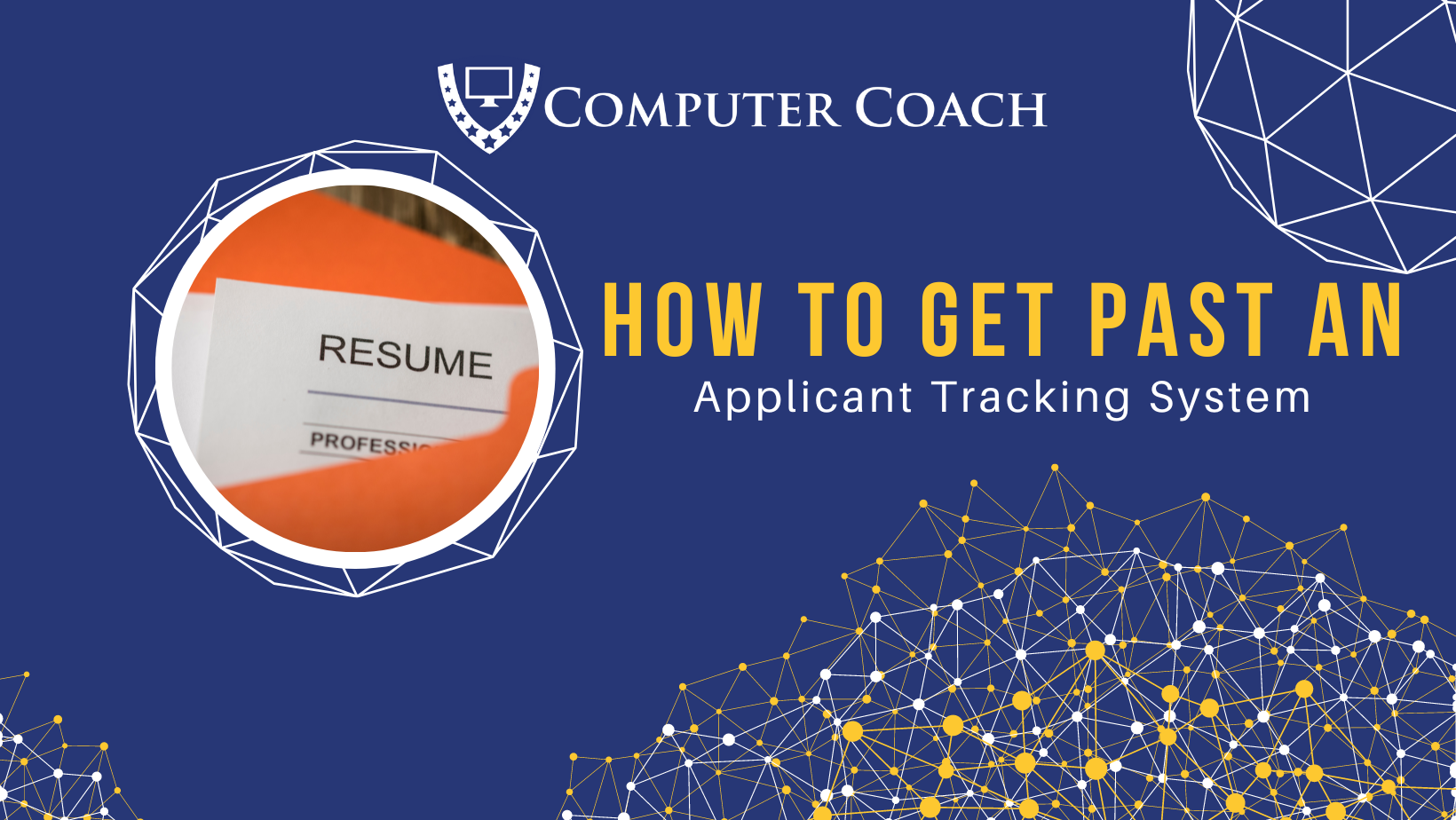Finding Success in a
Modern Job Search

Landing Your Next Job Doesn't Need to Be Difficult.
We specialize in finding the correct classes to learn the skills you need for your career.

Job searching has never been fun – from going business to business filling out applications to scouring the web for your next opportunity – it can feel daunting. Today, however, job searching can almost feel hopeless. A black hole of resumes and applications that never seem to get a response. Yet, people are finding jobs – so what are they doing different than you? First off, they’re not just sticking to one method of job searching. In today’s competitive market, you must employ every technique to stand out and make a connection. Try some of these “work smarter, not harder” methods to search for your next role.
1. Update your resume
Right, first lets address the elephant in the room. Is updating your resume a new technique? No – it’s not! However, it is still an absolute must. We all know when it comes to resumes, everyone has an opinion on how it should look, how long it should be etc. We’re not going to focus on format so much as content. When updating your resume, it should be BOLD.
• Build off the job description
• Offer value
• Limit your words
• Don’t leave gaps
Lets look at each of those a little closer.
Build off the job description
You’ve probably been told at some point to customize your resume for the role you’re applying to. That can seem daunting especially when you’re applying to several jobs a day, however, remember, these techniques are designed to land you your dream job. If you’re applying to any and every job, you probably don’t have to worry about this because it’s a numbers game at that point. Eventually, you’ll get a call – but if you want to focus in on the jobs you really want, this is a must.
When you’re customizing your resume to the job you’re applying to, it’s quite simple. Ensure your resume uses the exact verbiage as the job description. Don’t paraphrase, don’t assume you know what they’re asking for – copy it verbatim.
For example, if the job description says, “Perform hands-on fixes at the desktop level, including installing and upgrading software, installing hardware, implementing file backups, and configuring systems and applications”, then your resume should say that you’ve done exactly that. It would read as, “Performed hands-on fixes at the desktop level, including installing and upgrading software, installing hardware, implementing file backups, and configuring systems and applications”
This goes for job titles as well. If your title was Help Desk Technician but the job you’re applying for is Help Desk Analyst, then you should list Help Desk Analyst as the title, in the title section on your resume.
Offer value
That’s a pretty generic statement, right? What we’re talking about here is highlighting your career achievements. You need to have a “Career Highlights” or “Notable Achievements” section, ideally at the beginning of your resume. Here is where you’ll list your stand out moments that set you apart from the rest of the pack. For example, if you worked in a call center where the average time to resolve a ticket was 1 hour, however, your average time was 45 minutes, you want to let potential employers know that! You could say, “Responded to and resolved support tickets 25% faster than the office average”. You should list 3-4 highlights in this section.
Limit your words
Your resume should be a summary of what your roles and responsibilities are. On average, your resume gets 6 seconds to shine. That’s how long HR Managers and Recruiters look at a resume. If they don’t see something they like in 6 seconds, they will move on to the next one. So, you cannot bog down your resume with wordy paragraphs. You need to be precise and to the point, while still getting the meat and potatoes in there. For each job you list, you should have one sentence, at most, with a description of what the role was, and 5-6 bullets of what you did in that role. Those bullets should match the job descriptions “must haves”, if applicable.
Don’t leave gaps
Gaps on a resume are some peoples kryptonite. The unfortunate truth is, gaps are scary to potential employers. That being said, some of us have gaps and there’s nothing we can do about them now. The key is to fill them in. Shorter gaps are easier to fill in on paper. If you were laid off and it took you 6 months to a year to find your next job, then you may want to list your start / end dates in years. For example, if you worked in Job A from 6/2010 until 1/2015 and then you didn’t start Job B until 11/2015, you would want to list the dates as:
Job B: 2015 – Present
Job A: 2010 – 2015.
If your gap was over a year, you can still use the above technique, however, depending on how long it was, you may have to do some explaining. Did you work in an unrelated role? If so, were there any transferrable skills that you can list? Did you volunteer or work an internship? Did you go back to school? These are all things you can list to explain a gap. The goal is to get them interested enough to call you – then you can thoroughly explain anything you need to, but you have to get the phone call first.
2. Network – both in person and on social media
Majority of job vacancies are never advertised – this is often referred to as the “hidden job market”. So how do you find out about a job that’s never advertised? You network! LinkedIn conducted a study in 2016 and determined that 85% of jobs are filled through networking! That’s huge! You have to get yourself out there and network with other professionals who know what your industry is doing, and more importantly, what their company is doing.
If you don’t have a LinkedIn profile – get one! ASAP! It’s not only an easy way to network, it’s looked at as a negative to recruiters and HR Managers if you don’t have one. But don’t just stop at social networking. You need to get out there and meet people face to face. At the end of the day, recruiters and HR Managers are people and if you can make a connection with someone, you’ve already won half the battle!
I know in person networking can be time consuming, especially if you’re already working. Be selective and purposeful about the events you’re going to. Do research ahead of time. Know what companies are going to be there, look those companies up and see if they’re hiring. Have a game plan before you go. You should know from each event what you hope to get out of it. Three new contacts, one new job lead etc.
3. Work with Head Hunters and Recruiting Agencies
Recruiting Agencies can be a huge resource when you’re looking for a new role. If you’re currently working, finding a new job can be very time consuming. Head Hunters will do the work for you while you focus on your current job. If you’re not working, you have someone out there advocating for you! They have access to jobs that you may not ever hear about and they can streamline the job search process for you.
I know head hunters have earned a bad rep and some people aren’t thrilled about the idea of working with them, but the truth is they can get you exposure quickly and most of them are great to work with. Thousands of employers opt to work with recruitment agencies because it cuts down on the lengthy process of locating and interviewing candidates. You really don’t have anything to lose by working with a recruiter, but you can gain a lot!
4. Consider taking a Contract Position
Today’s workforce is very different than that of our parents who probably worked at the same company for 30 years. You just don’t see that these days, and quite frankly, it’s not looked at positively anymore. It’s estimated that IT Professionals will change jobs every 2 years, on average. It’s also estimated that the average project lasts 2 years. Coincidence? Probably not. More and more people are opting to work contract positions, and there are several reasons why.
A poll by NPR/Marist found that 1 in 5 jobs in America are held by contract workers and that number is probably much higher in the IT industry. Employers often times just don’t have time to use traditional methods to hire full-time, permanent employees. It’s much more cost effective to use a Staffing Agency and hire contract employees where they’re not as focused on long term fit, but can you get the job done! Because of that, contract opportunities are becoming the norm in IT.
The hiring process tends to be much shorter with contract positions. Again, you don’t have to consider things like long term fit, how long you were at your last position, referrals and references. It’s usually pretty straight forward – do you have the skill, and can you complete the project?
Contract roles usually pay more than permanent positions. Again, there are many reasons for this. The positions are usually shorter term, with the average contract lasting 6 months to a year. The employer doesn’t have to worry about things like healthcare and employee benefits. However, there is a huge misconception that contractors have to pay their own taxes and don’t get healthcare. In reality, most firms offer W2 contract positions and healthcare, depending on the length of the contract.
One of the biggest advantages of working a contract is that you will likely have an opportunity to work on the latest technologies which you can put on your resume, opening doors for future opportunities. This is one of the fastest ways to gain experience with a technology you never had the chance to learn and progress your career.
Finally, some people are hesitant to take a contract position because they think it will look bad or like you’re a “job hopper”. Sure, there will be some companies that are looking for more stability in your employment history, but for the most part, employers aren’t as worried about that anymore. This goes back to understanding the current job market and knowing that employees are not going to be with your company for their entire career.
Bottom Line
Looking for a job in today’s market is a process, there’s no getting around that. Just keep in mind that there are lots of ways that you can set yourself apart and get ahead of the pack. Be adaptive, open minded and use every resource available to find the best opportunity for you. And when you do land your dream job, remember to stay active in your industry so that your next opportunity comes organically!
CHECK OUT THESE OTHER RESOURCES
ABOUT COMPUTER COACH

Computer Coach is a trusted and experienced technology training and career development center, providing comprehensive and customized training solutions to empower individuals and companies to succeed in the rapidly evolving tech industry. With a focus on both hard skills and soft skills development, our personalized approach sets us apart in the market, making us the preferred training partner for tech talent nationwide. www.ComputerCoach.com
corporate headquarters
5005 N. Hesperides Street
Tampa, Florida 33614
(813) 947-0552

Please note: Not all courses on our site are under the purview of the Florida Commission for Independent Education (CIE).
USeful Information
USeful Information
Follow & Connect with Us
Copyright © Your Company. All Rights Reserved.




